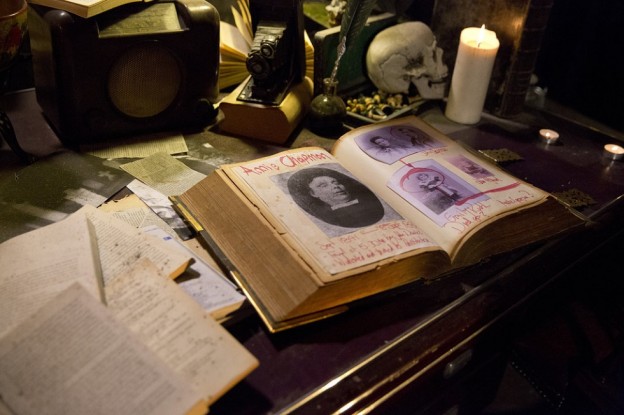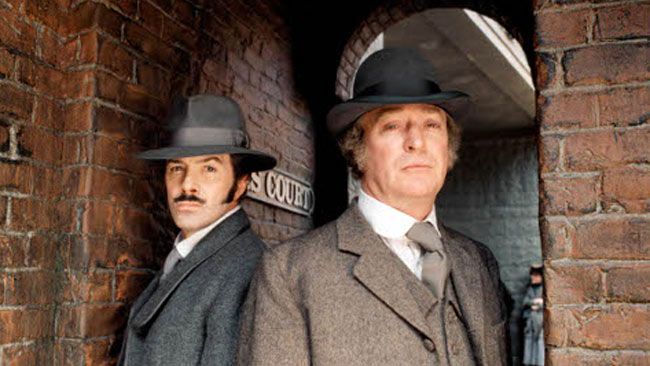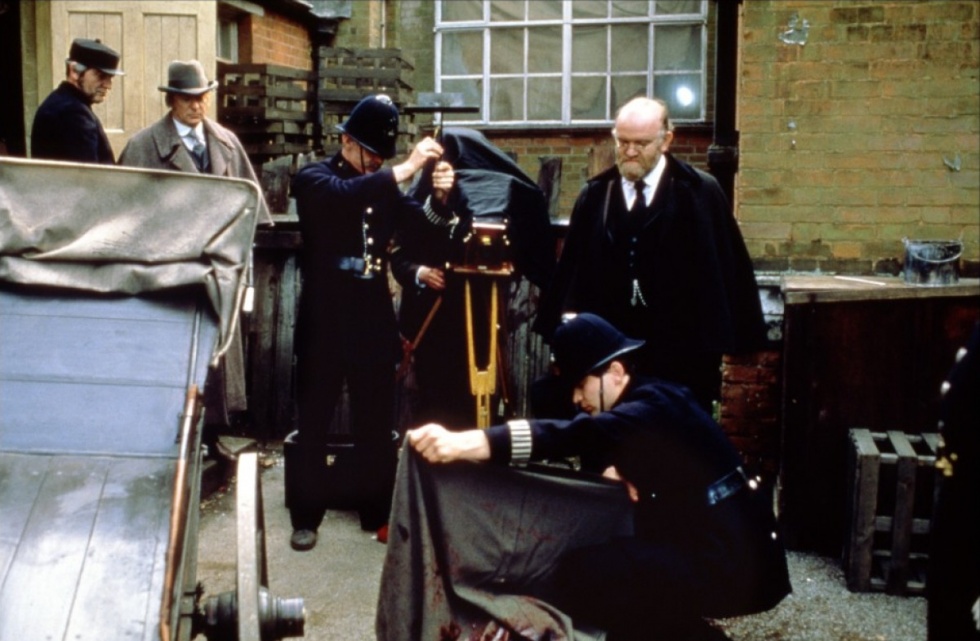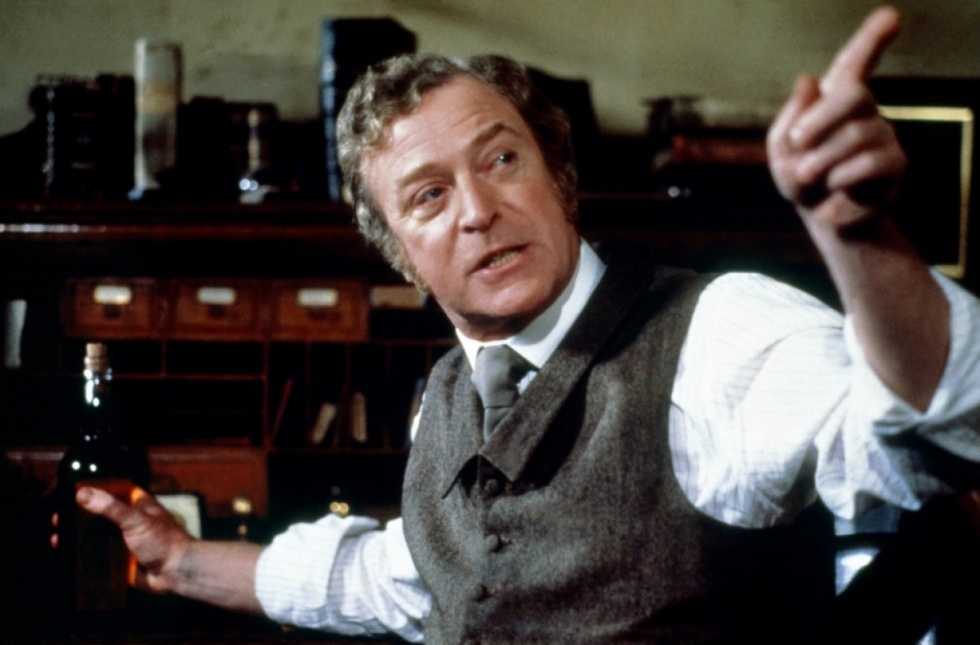What if someone had discovered the knives used by Jack the Ripper?
What if they went missing?
What if he came back into our world?
Damian Michael Barcroft finds out in an exclusive interview with the film’s co-writers and directors, Ian Powell and Karl Ward…
 Damian: Razors is a British independent film and the first in a new horror franchise. The story concerns the discovery of the knives used by Jack the Ripper. Are you using the iconography associated with the Whitechapel murders of 1888 for cinematic and dramatic effect or is there also particular reference made to any of the suspects and their history?
Damian: Razors is a British independent film and the first in a new horror franchise. The story concerns the discovery of the knives used by Jack the Ripper. Are you using the iconography associated with the Whitechapel murders of 1888 for cinematic and dramatic effect or is there also particular reference made to any of the suspects and their history?
Ian: We don’t really make reference to the suspects in the first film, but certainly the inclusion of the Ripper is not there purely for cinematic effect. The location where the story is set is pretty unique and has a resonance and relevance to the Ripper story. It isn’t in fact the Asylum where we originally intended to shoot, but a building in Islington that dates from the 1880’s, and was originally a veterinary hospital for horses. It is now used as a club, but its Victorian origins are all too obvious when you venture into the depths of the building, something we have enhanced by lighting the old brick stairways with flaming candles. As the central story is about a group of very genre aware screenwriters, using the location to inspire the writing of a ground breaking horror story, one of the leaping off points for the film is a questioning of the morality of writing a horror film, and especially one written around real events. The Ripper killed five real women in terrible ways and without wishing to give the game away it is the victims who take on a special significance in the film. The screenwriters are haunted by the ghost of a little girl from the Ripper’s time, she is trying to bring their attention to a terrible event from the past and part of the mystery for the audience is working out her identity.
Karl: For Razors the focus is more on the horror and fear of what the Ripper did to his victims. The story is orientated around the exploration of fear and the unearthing of a fictional history based on the facts in regards to the victims. So our attention is on the victim and not the Ripper himself. For the next films we are going to delve deeper into that world of Jack. We just didn’t want to tackle too much in one go.
Damian: What can you tell us about your Jack the Ripper mythos and how you have managed to transport the Victorian characters and events into a contemporary setting for the film?
Ian: In Razors a troubled young screenwriter, Ruth Walker, is one of six screenwriters taken to a unique Victorian location, a place with a history, by their enigmatic tutor Prof. Richard Wise. All must pitch the ultimate horror movie and Wise will chose one story that they will then develop together using the building for inspiration. But Ruth has the ultimate pitch in that she believes a box that she has inherited contains the knives used by Jack the Ripper, and she has been told never to open it. (Quite how she has obtained the box is explained later in the film). No one of course believes her but after the pitches, and as the competition between them hots up, the knives go missing and it seems that the spirit of the Ripper exists behind the walls of the building and is being slowly reborn. The screenwriters have been drawn to writing horror by nightmares they have had since childhood and a shared sense of doom.
At the risk of giving away too much of the plot, (some plot spoilers ahead) the screenwriters are haunted by the ghost of a little Victorian girl who seems to be drawing them towards a long hidden secret, and the film hints at a possible sixth, undiscovered Ripper murder that happened in a chamber hidden behind the walls. The Police interrupted it and although the Ripper escaped, managed to take his knives but not before the little girl hid one of them within the walls and trapping the spirit of the Ripper there. Thus to stop the Ripper once and for all, and to prevent his escape into the wider world, Ruth must find the missing knife and use it to destroy him. In doing so the screenwriters will discover the identity of the little girl and their own particular relevance to the Ripper’s story, which is the film’s big final twist.
Thus in Razors we set up a concept that can be developed further in later films. The knives are a kind of seal on the Ripper’s tomb and wherever they are now taken, the avenging spirit of the Ripper will follow.
Karl: Our Jack the Ripper could be anyone. He could be your brother or best friend. As we all know there are many theories about who Jack was but for us the importance was what he stood for. He is a symbol of fear that everyone all over the world can identify with. We do drag other characters contemporary to Jack’s time into the film (we get a cheeky glimpse of Abberline amongst others), but the idea is to mirror the events of that time and not to reproduce it. Fear of the unknown is the ultimate duality between the mythos of that time and of our society now. Imagine Jack as an ideology for terror… A terror threat. Something everyone fears yet cannot avoid. A hellish image of pain and suffering.
 Damian: We obviously don’t want to reveal too much but can we talk about Andrew Shire who plays Jack the Ripper and how you approached the writing and directing of such an enigmatic character?
Damian: We obviously don’t want to reveal too much but can we talk about Andrew Shire who plays Jack the Ripper and how you approached the writing and directing of such an enigmatic character?
Ian: I think we very consciously went for a different look for the Ripper and wanted to avoid the top hat and opera cloak approach. I took the Ripper tour and was struck by the idea that he could have been a workman from a slaughterhouse, who could have got blood on his clothes and entered a public house in the early hours of the morning without arousing undue attention. Karl has come up with a really cool story idea for the identity of the Ripper which we will explore in one of the sequels; it is a plausible and intriguing concept but not one that pretends to be based on historical fact or the existing list of suspects. As to Andrew, he is an extremely powerful actor who I had used in my previous film, Seeing Heaven. He looks very enigmatic and really gives it his all. He is a sinister presence in this film, and subsequent films will need to build more on his character, but he brings a pretty deranged approach to playing the Ripper which is a nice contrast to the usual black eyed enigmatic figure of evil in From Hell.
Karl: Andrew and myself worked a lot on making sure the approach to such an iconic character was fresh. We wanted the character to be familiar but certainly not the typical Jack the Ripper you see in comics or drawings scattered all over the place. I tried to keep Andrew as distanced from the other actors on set as possible; I wanted to alienate him as an actor from the others. As a character he doesn’t say much in the film so it was important to work on physicality and to keep Andrew focused on his motivation which I will not reveal. As you say, that would give too much away. The dialogue between Andrew and I on set was rather unsettling. We got a few funny looks from the rest of the cast and crew as they heard little glimpses of what I whispered to him. Thankfully Andrew was excited by this approach and went along with it. The result I feel is very animalistic and daring.
Damian: Were you tempted to watch the classic screen representations of Jack the Ripper such as Murder by Decree or the Michael Caine miniseries for example?
Ian: I have seen both, the Michael Caine series when it originally aired and Murder by Decree when it was shown back in the late 70’s or early 80’s on TV. So Murder by Decree is a strong memory from my youth. I think it is a superb film. I think I also dimly remember the Z cars detectives take on the Ripper case programme that started off the Royal theory thread. I would have liked to have referred more to particular elements of the Ripper murders and to have woven them more into our present day story. These elements were present in the original shooting script (e.g. the writing chalked on the wall that is wiped off by the chief of Police) but this evolved a little in shooting and now this first Razor’s film concentrates more fully around the story of the central character Ruth who has the knives and her five fellow script writers. To be honest a whole host of influences have gone into the film, including the idea of the little girl from Hands of the Ripper although in this film she is not the Ripper’s daughter, and we have used her character to design a new twist. There is also a nod with her to Mario Bava’s Kill Baby Kill and the idea of little Ghost girl’s in Peter Straub’s work…especially the Mia Farrow film Full Circle. There are also references to The Stone Tape with the building keeping an essence of past events.
Karl: I had seen clips when I was younger… I love Michael Caine. Anyway, for me the film is more of a psychological struggle of upbringing and fear so I researched a lot into real serial killers such as Ed Gein, Charles Manson and others. It’s always fun to see interpretations of a character through other films yet to create something a little fresher I felt that finding real case studies was more useful. I tend to get more influenced by music, sound and objects than anything else. For me that’s always a good starting point. To name a couple of tracks Justice Stress and the Nick Cave and Warren Ellis score for The Road.
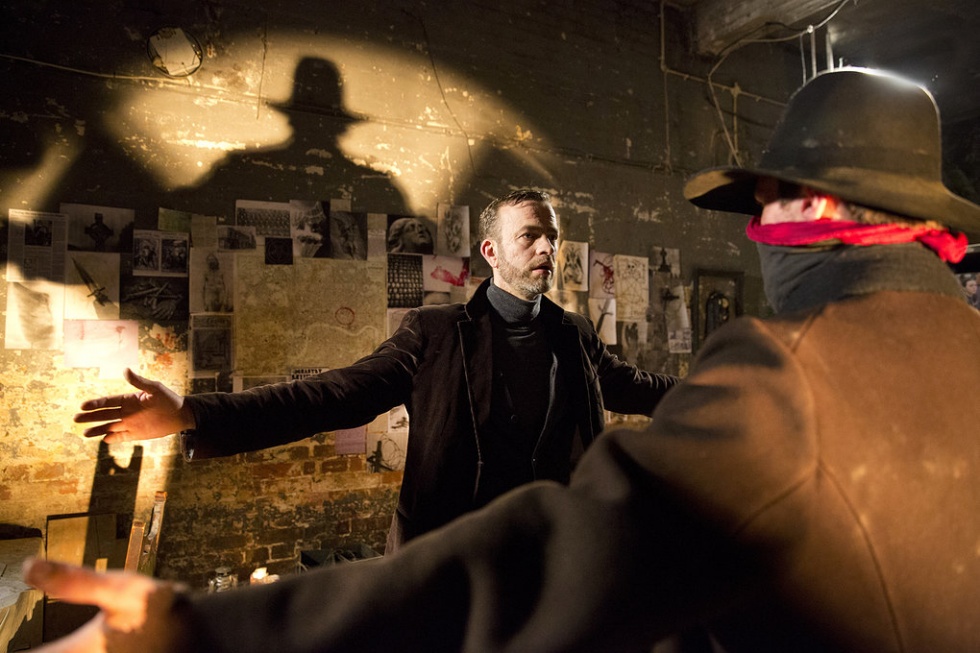 Damian: Again, avoiding spoilers, can you tell me more about Professor Richard Wise?
Damian: Again, avoiding spoilers, can you tell me more about Professor Richard Wise?
Ian: Professor Wise is a professor of screenwriting who takes five of his most gifted students to the old Victorian location at the centre of the film, for a kind of horror boot camp, to encourage them to explore their fears and write the ultimate horror story. But of course he may also have an ulterior motive. Wise believes in “bad places” that have existed throughout history and can exert an influence on the present.
Probably the biggest influence on Razors is the original Robert Wise film of The Haunting. Thus Professor Wise is a bit of a homage to the Richard Johnson character in that film. He is very much in the tradition of learned authority figures who takes a group of characters to a historically significant place with somewhat murky motives. He is a scholar and as the film progresses we might begin to wonder quite what it is he knows about the Ripper murders and the way that the five screenwriters, despite being modern characters, might fit in to them. The big twist of the film is that they are more intimately involved than you might think. Thomas Thoroe plays Wise with a nice enigmatic and icy edge. He is affable but also a little bit scary.
Karl: A sick, macabre, Faustian mess.
Damian: The aforementioned plot element featuring the idea of a group of writers competing to write the ultimate horror story reminds me of that dark and stormy night in 1816 when a group of friends including Shelley, Byron and Polidori challenged each other to a similar endeavour which resulted in the creation of Frankenstein. I was wondering if this was a deliberate homage?
Ian: That was a wonderful story, but I suppose here we have taken a bit more of a Scream approach as the characters are young screenwriters. The stories that the screenwriters pitch to each other, tell us a lot about their characters. So Zack the American pitches a Hostel type bloodbath, James the English geeky guy, something more intellectual, Sadie and Jane, an Elizabeth Bathory type vampire story that they have worked on together. I guess the similarity with the gothic story is that Ruth (like Mary Shelley) has a complicated Freudian back story that influences what she writes, a history of violence at the hands of her own father etc.
Karl: I wish I could say it was. Regardless, I love the comparison. Shelley’s gothic novel is a massive influence on me as a writer. Thank you.
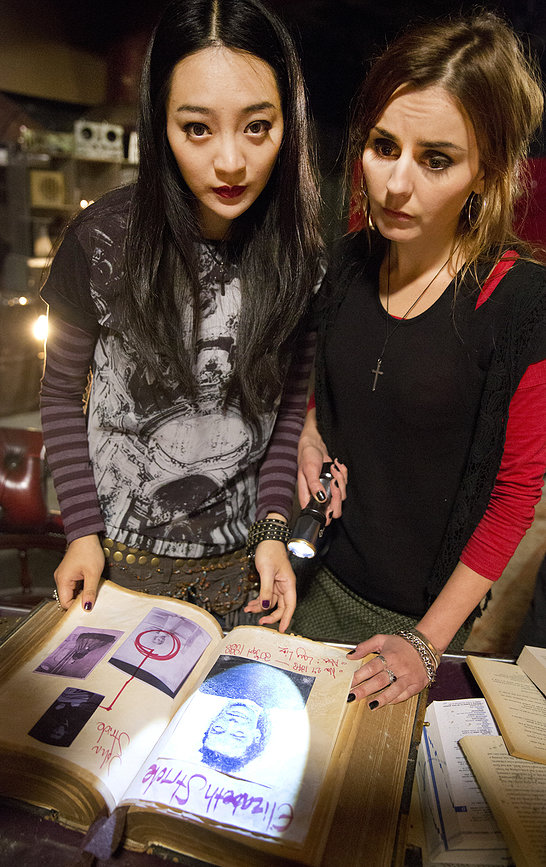 Damian: Your production company, Magic Mask Pictures, specialises in visually striking and high concept fantasy/horror films, given that Razors has the aforementioned present-day setting, to what extend does the meticulously crafted lighting shot by the award-winning cinematographer, Alessio Valori, attempt to evoke Jack the Ripper’s Victorian East End of London?
Damian: Your production company, Magic Mask Pictures, specialises in visually striking and high concept fantasy/horror films, given that Razors has the aforementioned present-day setting, to what extend does the meticulously crafted lighting shot by the award-winning cinematographer, Alessio Valori, attempt to evoke Jack the Ripper’s Victorian East End of London?
Ian: In Seeing Heaven my last film, Alessio went for a very intense use of primary colours as a homage to the great Italian fantasy director Mario Bava. In this film the use of colour is more restrained but Alessio wanted to stick to a discipline of largely lighting the scenes with candles and the characters’ torches, augmented with relatively few film lights and neons. The textures of the walls and other elements of the junk filled building give it a special ambience and we didn’t have to do much to create an oppressive atmosphere. Ironically, the actual location we used is full of secret rooms filled with collections of objects and in fact, it also houses a scrap metal yard which the police have used to destroy knives and other weapons, thus the plotline around the knives has a small echo in the building’s real history. I would also mention that we were very lucky to have David Blight designing our costumes and he has worked on a large number of TV costume productions. So in the few instances when we skip back to Victorian times, the costumes look authentic.
Karl: We used a lot of natural light from candles in the film. This meant we could move around the locations quickly and get more shooting material logistically, but it also mirrored the lighting states that would have been seen at the time. Alessio is an incredibly passionate cinematographer and the proof of his expertise is in the shots themselves. For the time we shot it in and the budget, Alessio has really produced imagery that surpasses what was expected. When Ian and I started to look through what we had captured we couldn’t wait to hit the editing suite.
Damian: You’re a great admirer of the directors Dario Argento and George A. Romero, do you think the work of these two icons of the horror genre have influenced your films or the visual style of Razors?
Ian: I love the politics and social themes of Romero’s movies and I am a big fan of the ingenuity of Argento’s early movies. However I am a bigger fan of Mario Bava, with his ability to create a sense of pure dream states in his films and to use colour to signify passion and emotion. We are currently working in the edit in the dream montages, and if we can get the audience to lose themselves within them, we will have achieved something. I am also a big fan of practical effects and atmosphere rather than CGI and Alessio Valori our cinematographer is very skilled in this regard. So even before colour grading, the film has a distinctive look that is all achieved in the camera and through skilful lighting.
Damian: You’ve recently completed principal photography and are currently in post-production, when can we expect Razors to be released?
Karl: This year. It’s a lengthy process but we are working closely with editor Euan Donaldson to create a film that is exciting for an audience to watch. The film is shaping and moving in ways we never anticipated before. It’s scary and exciting, but ultimately cannot be rushed. There are moments when things slot into place and I feel genuinely anxious about what is going to happen in a scene I’ve seen numerous times. I hope that the auditorium will be inquisitive and a bundle of nerves. But to be honest, I am not sure if I could sit in there with them!
Ian: I would also just like to add that the film has another East End connection in that we worked closely with students from the SAE institute in Haggerston, who got their first feature film credit, working with us on the film. We are hopping when the film has finished that it will have an East End cinema premiere.
Damian: As you’ve already mentioned, Razors is only the first chapter in an ongoing series of films. What is your overall vision for the franchise?
Ian: We just want to create and intelligent and different horror franchise that goes beyond the usual teenagers in peril formula. The Ripper’s knives will get stolen in one of the sequels by an unscrupulous art dealer and will turn up in America, where of course it is thought by some that the Ripper actually escaped to after the five core murders, with additional murders happening there. We also plan a slightly post-modern detour in one of the sequels, with the writer of the original film, haunted by the ghosts of the Ripper victims, who implore him to find out the Ripper’s true identity, as they never actually saw his face. (As a Shoreditch resident when I walk around Brick Lane I am very conscious of the actual locations of the murders).
Karl: We will delve deeper into the mythos and explore darker corners of its world. We have a few tricks up our sleeve both period and surrealist – you’ll just have to wait and see!
Damian: Ian and Karl, thank you very much indeed.
~
